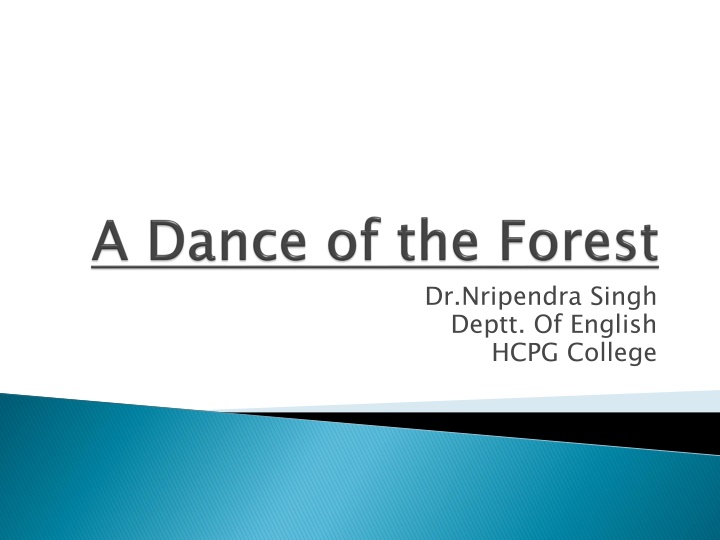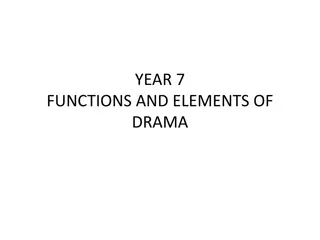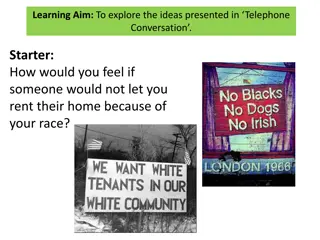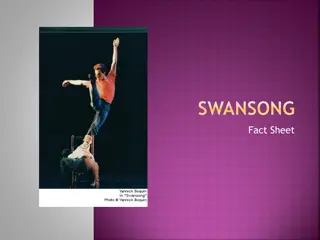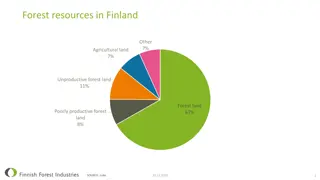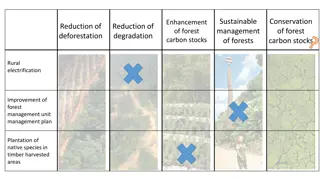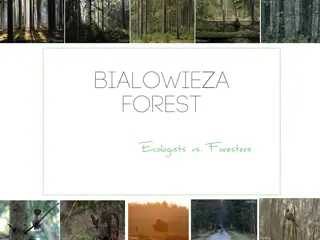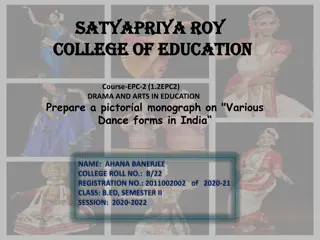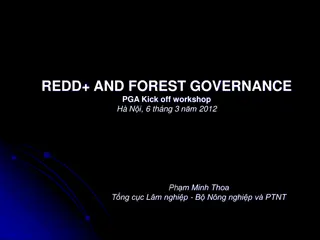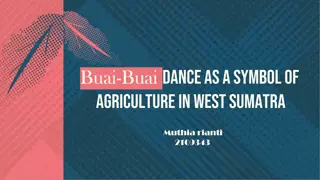A Dance of the Forest: A Cautionary Play by Wole Soyinka
A Dance of the Forest by Wole Soyinka is a renowned play that delves into themes of political corruption, Nigerian independence, and the interconnectedness of the living and the dead. Through a cast of characters like the Dead Man, Dead Woman, and Madame Tortoise, Soyinka crafts a cautionary tale urging vigilance and critical thinking among the Nigerian people amidst their new independence. The play serves as a metaphor for not idealizing pre-colonial Africa too much and underscores the importance of remaining aware and seeking truth.
Download Presentation

Please find below an Image/Link to download the presentation.
The content on the website is provided AS IS for your information and personal use only. It may not be sold, licensed, or shared on other websites without obtaining consent from the author.If you encounter any issues during the download, it is possible that the publisher has removed the file from their server.
You are allowed to download the files provided on this website for personal or commercial use, subject to the condition that they are used lawfully. All files are the property of their respective owners.
The content on the website is provided AS IS for your information and personal use only. It may not be sold, licensed, or shared on other websites without obtaining consent from the author.
E N D
Presentation Transcript
Dr.Nripendra Singh Deptt. Of English HCPG College
A Dance of the Forest is one of best-known plays of Nobel laureate Wole Soyinka and was commissioned as part of a larger celebration of Nigerian independence. It was a polarizing play that made many Nigerians angry at the time of its production, specifically because of its indictment of political corruption in the country. Soyinka wrote this play in 1959, submerging himself in Yoruba folklore as a way of reconnecting with his homeland.The play is about a group of mortals who invoke the spirits of the dead, hoping that these wiser spirits will help to guide them,but disappointed to discover that the spirits are just as petty and flawed as they are.The play has been interpreted by many as a cautionary tale for the Nigerian people on the occasion of their newfound independence, to remind them to be critical and seeking, and warning against becoming complacent. It also provides a metaphor for not sentimentalizing pre-colonial Africa too much and remaining vigilant. When Soyinka won the Nobel Prize for Literature in 1986, A Dance of the Forests was named as one of his crowning achievements, and he was named "one of the finest poetical playwrights that have written in English.
The play begins with an introduction by Aroni, "the Lame One," laying out the circumstances of the play. Soyinka lists the characters, and describes them. The Dead Man was a captain in Mata Kharibu's army, the Dead Woman was his wife. Rola is a prostitute and goes by her name from long ago, Madame Tortoise. Adenebi, another character, is the court orator, and is oblivious to the existence of the dead people. He used to be the court historian. Demoke, the Carver, was a poet in his previous life. Agboreko is known as "The Elder of the Sealed Lips," who made sacrifices for the Forest Head. The Forest Head is disguising himself as a mortal, Obaneji. Aroni has secured the Dead Man and Woman as two spirits of the restless dead. In an empty clearing in the forest, first the Dead Woman pushes her head up through the soil, then the Dead Man. The man is "fat and bloated according to the stage directions, and wearing traditional warrior clothing, and the woman is pregnant. They do not see each other, and Adenebi enters. As Adenebi passes, the Dead Man asks him for help and Adenebi gets scared and runs off. The Dead Woman and Dead Man are confused, thinking that they would have been greeted by the living. Obaneji enters, looks at them, then retreats as wellWhen Demoke enters and the Dead Woman asks him to take her case, he tells her he's in a hurry, saying, "When you see a man hurrying, he has got a load on his back. Do you think I live emptily that I will take another's cause for pay or mercy?" She tells him she lived here once, but he insists that it was before his time and goes on his way. Rola enters seductively, and when the Dead Man asks her to take his case, she agrees, before realizing that he is dead and becoming afraid of him. She scolds him and tells him that in his condition, it was nervy of him to solicit her for help. The Dead Woman bemoans the fact that no one will recognize or help her, even though she was summoned back to the world of the living, and the Dead Man is ashamed of Rola's treatment of him. "The world is big but the dead are bigger," says the Dead Woman.
Using the theatrical space, playwright Soyinka stages the passage from the world of the living into the world of the dead, and the ways that these two realms are not so distinct. After popping out of the soil, like ghoulish zombies, the Dead Man and Dead Woman seek to communicate with the living, but are met with fear or indifference. They are not ghosts exactly, or angels, but beings that are somewhere between the world of the living and the world of the dead. The stage acts as a liminal space between these two realms, representing that something about their existence is unresolved or "in-between. The play deals with highly abstract and spiritual plot points. The Dead Man and Dead Woman are symbolic of people who were abused in their previous lives by Rola, Demoke, Adenebi, and Agboreko. Thus, the premise of the play rests on a narrative of redemption in the present of wrongs and injustices suffered in the past. In this conception of how existence works, death is an opportunity to write the past: it is a cyclical process, in which the past, present, and future are always layered atop one another. Soyinka uses mythological and surreal scenarios and characters to comment on corruption in government and human error. When the four mortals return to the clearing in the woods after the Dead Man and Dead Woman leave, Obaneji tells a story about a politician who took a bribe so that a lorry could be overloaded with passengers. The lorry then caught on fire and 65 of the 70 passengers died, and he wants answers about who took the bribe. Adenebi, the council orator, becomes defensive and can provide no answers about the incident, and we see that among the mortals are corrupt and fallible members of the government. In the discussion of The Incinerator, the lorry that caught on fire, we see that Adenebi is more interested in covering up the violence of the incident than in uncovering how the incident came to happen. When Obaneji confronts him about the fact that he has a great deal of authority and must know more about how the bribe came to pass, Adenebi points his finger at Obaneji and accuses him of being disrespectful of the people who died. He hides behind a performed mournfulness about the event when called upon to clarify what really happened. This moment reveals a kind of political hypocrisy that Soyinka is interested in exposing with the play.
works with fire as a carver, that he is not afraid of it, but that he would never want to die by being burned. When his companions question him about how he would prefer to die, he says that he would rather fall from a great height and alludes to his apprentice. He rationalizes that, "If I can pull my body up, further than it will go, I would willingly fall to my death after. While death is a major theme from the start as the central plot concerns the Dead Man and the Dead Woman, the play also explores the subject of death from the perspective of the living. First, Obaneji talks about death as a consequence of political corruption, discussing the overturned lorry. Then, Demoke chimes in and talks about how in his job he has to climb very high, and if he were to choose his death, he would choose to fall from a great height. The mortals discuss death in the abstract, all in violent terms: falling, burning, being killed. The mortals in the play are petty and childish, fighting and squabbling about how they would die and pointing fingers about who is responsible for what violence. In this way, Wole Soyinka makes a parody of existence, and shows that life on earth is a series of fights and petty accusations. The mortals reveal their secrets and, in the process, become angry and impatient with one another. A momentous revelation occurs in this section when Obaneji reveals the identity of Rola in her former life, she was an infamous prostitute named Madame Tortoise. This revelation has a variety of effects. In Adenebi it inspires complete revulsion, as he remembers that Madame Tortoise drove men to fight with one another. In Demoke it inspires awe and admiration, as he once carved a totem in her honor. Rola herself is for a moment horrified to be found out, and then completely indignant and unrepentant about her former self. Demoke also makes a revelation in this section when he tells the story of killing his apprentice, Oremole, and the creative inspiration that the violent act gave him. In this monologue, we see the contrast between Demoke's negative impulse, his desire to kill, and his desire to create, a more positive impulse.
In the world of the play, the past and present are blurred in that people are strongly linked to their descendants even in the world of the present. The revelation that Rola is Madame Tortoise, for instance, is at once the revelation of the fact that she is the descendant of an infamous prostitute named Madame Tortoise, and also that she is Madame Tortoise in the present. There is an elision made between the world of the living and the world of the dead that suggests that the characters cannot escape their origins, that no individual is simply who they are, but they each carry the crimes, sins, and insecurities of those that came before. As they begin to piece together what is happening, Adenebi, the Old Man, and Agboreko begin to see that Aroni has summoned the dead to come back and, in effect, "haunt" the mortals who have done them wrong in the past. There is unfinished business to be reckoned with and injustice that needs to be remedied. The dead couple is there to remind the four living subjects of the crimes they committed in the past. The world of the dead has something to teach the living. The Old Man, Agboreko, and Adenebi have convened, they perform a divination ritual and dance in order to welcome the dead. These rituals have historical and spiritual precedent, and while they do not necessarily appear to have a literal bearing on the plot itself, they affect the characters deeply and portend the reckoning that is to come. Wole Soyinka blends not only elements of European drama and African myth, but also the world of humans with the supernatural. Spirits like Eshuoro, Aroni, and Murete move through the world with an elevated power and a special place in the fabric of the forest, yet they squabble and have appetites just like the humans over whom they preside. Murete loves nothing more than getting drunk in his tree dwelling, and Eshuoro experiences envy and resentment at not being invited to the welcoming of the dead. Embedded in the thematic narrative of the play is the struggle between the human world and the natural world, as it is presided over by the gods and spirits. A god like Eshuoro resents the humans for meddling with his forest, particularly resenting Demoke for carving something in one of his tallest prize trees. Meanwhile, the Forest Head is more at peace with the human world, even if he too is meddling with it in his own ways, by disguising himself as Obaneji and following Aroni's lead.
After much confusion and chaos, we find that Aroni and the Forest Head are in full control of what is going on. When they speak to one another, they discuss the fact that the assemblage of mortals is completely intentional. Additionally, they reveal that they have made it so that Eshuoro will follow them to the festivities to scare the mortals. What has seemed like a variety of chaotic competing interests is in fact being presided over and controlled by these forest spirits. The play takes a turn when the onstage events actually transport back in time 8 centuries to the court of Mata Kharibu. After so many allusions to the past lives of the characters, the theatrical world brings us back to the actual events that have led to the unfinished business with the dead couple. The chaos of the forest is replaced with the order of the court, and we see the ways in which each of the four mortals mistreated the two dead people a captain in Mata Kharibu's court, and his wife. In the court of Mata Kharibu, we see the conflict between the merciless king and the Dead Man, who was once a soldier in his court. The main point of contention between them is the fact that the soldier had the audacity to think, which is distasteful to the king. When charged with having thought, the soldier can only perform humility, saying, "I plead guilty to the possession of thought. I did not know that it was in me to exercise it, until your Majesty's inhuman commands. The court of Mata Kharibu transports the reader into a much more recognizable monarchical structure, it reveals once and for all the corrupt identities of the courtly subjects who will eventually become the four mortals collected by Aroni. We also see the context for the dead couple's suspension between the world of the living and the dead.
While the play is an indictment of an African nostalgia that ignores the problems of the past,Wole Soyunka`s work, and this play in particular, is held up as a masterful example of his incorporation of traditional Yoruba ritual performance modes. These elements include the use of masquerade, dance, poetry, music, and the depiction of possession. Thus, the events onstage are not simply symbolic or figurative, but represent and recreate actual modes of performance that hearken back to Nigerian history and traditions of the culture itself. Each of the characters, save for the spirits and gods, has had some past experience that they carry with them into the theatrical present. In the world of the living, no one is ever just who they are born as; they also carry the story of who they were before with them into the present. This continuity is something close to reincarnation, but almost more immediate, as the separate lives are even less distinct, and present identities are laid over past ones more indiscernibly. Much of the action in the play consists of non-literal, figurative or ritualistic scenarios that hearken back to traditional modes of Nigerian performance. In this way, the magical or supernatural elements are not necessarily labeled as such, but are simply extensions of the literal action onstage, rituals in themselves in which plausibility is not a concern. When spirits are summoned, or characters become possessed, it is simply stated that this happens in the stage directions.
Symbols used in the play Symbols used in the play Smoking out the forest The Old Man sends for a truck to smoke out the forest with the petrol fumes, all in order to find his son. This event is symbolic of the ways that humans are willing to disrupt and destroy nature in order to get what they want. Coin purse In the court of Mata Kharibu, the Slave-Dealer hands the Historian a coin purse in exchange for his agreement that his ship is worthy vessel. The coin purse is a symbol of how bribery and corruption work in the court of Mata Kharibu. People are willing to get paid off in order to turn a blind eye to injustice, and the coin purse symbolizes their greed and the fact that they can be bought. Out of the Soil Dead Man and Dead Woman come up out of the soil in the opening of the play, which symbolizes their journey from the subterranean world of the dead to the world of the living. It represents that they are not alive, but it also represents that they have unfinished business, and that they come with issues that have been buried and that they are literally and figuratively bringing to light.
While many celebrated the play when it was first performed in 1960 to celebrate Nigerian independence, its critics believed that it was attacking Nigerian politics and interpreted it as a warning for the future. Many of the play's critics were members of Nigeria's elite who saw the play as exposing post-colonial Nigerian politics as corrupt. The play has been interpreted as an allegory for the ways in which Nigerians were tasked with casting away the structures of colonialism and beginning anew, trying to find better political modes. While Soyinka's depictions of mortals and spirits alike as fallible can be read as an indictment of Nigerian politicians in the post-colonial moment in which it was written, it can also be interpreted as offering a more idealistic vision of what might be in the future, the possibilities and potentials for a country on the brink of crafting a new identity.
